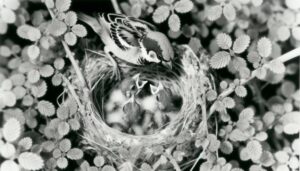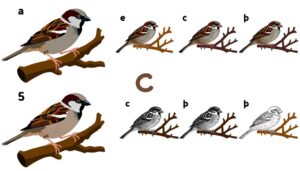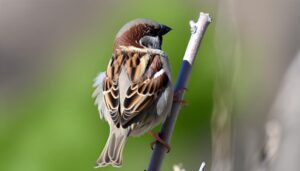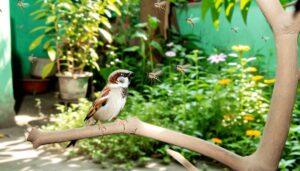5 Key Differences Comparing Female House and Song Sparrows
The female House Sparrow (Passer domesticus) is more robust, measuring 14-16 cm, with uniform brownish-gray plumage and a conical beak for seed-cracking. Conversely, the female Song Sparrow (Melospiza melodia) is slightly smaller at 12-15 cm, with a slender, elongated shape, streaked brown feathers, and a tapered beak suited for insects and seeds.
House Sparrows are highly sociable in urban settings, nesting in artificial structures, while Song Sparrows favor marshes and shrublands, exhibiting high territoriality. House Sparrows are non-migratory, living 3-5 years, whereas Song Sparrows may migrate and live 6-9 years.
Discover more intriguing insights about their interactions and lifespans.
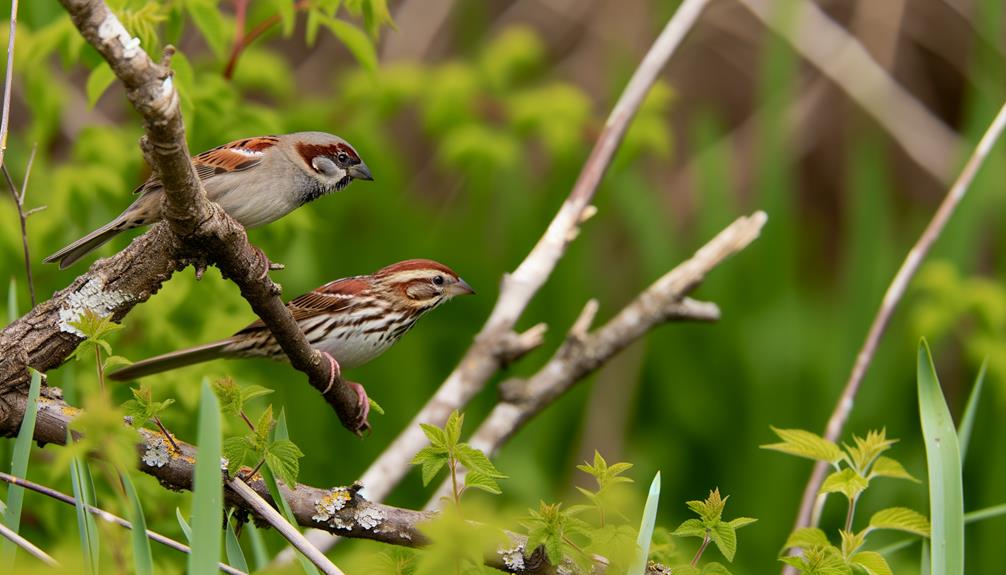
Key Takeaways
- Female House Sparrows are larger and more robust compared to the smaller, slender female Song Sparrows.
- House Sparrows have uniform brown-gray plumage, while Song Sparrows display streaked breasts and varied brown patterns.
- House Sparrows possess a conical beak for seeds, whereas Song Sparrows have a slender beak for insects and seeds.
- House Sparrows thrive in urban areas and nest in artificial structures; Song Sparrows prefer natural habitats and nest near the ground.
- House Sparrows exhibit high flock cohesion and low territoriality, while Song Sparrows have low flock cohesion and high territoriality.
Physical Appearance
The physical appearances of female House Sparrows (Passer domesticus) and Song Sparrows (Melospiza melodia) exhibit distinct differences in plumage coloration, overall size, and morphological features.
Female House Sparrows are generally more robust with a stockier build, measuring approximately 14-16 cm in length. They possess a more uniform, muted brownish-gray plumage.
Conversely, female Song Sparrows are slightly smaller, averaging 12-15 cm, and exhibit a more slender body structure. Morphologically, Song Sparrows have a rounded head and a longer, more tapered tail. Their plumage, while also brown, tends to be streaked and more varied.
These differences in size and shape contribute to their identification and reflect adaptations to their respective ecological niches.
Coloration Patterns
In examining the coloration patterns of female House Sparrows and Song Sparrows, one observes distinct differences that aid in their identification and reflect their ecological adaptations.
Female House Sparrows (Passer domesticus) exhibit a more uniform coloration with shades of brown and buff, featuring a distinctive greyish crown and nape.
In contrast, female Song Sparrows (Melospiza melodia) display a more complex pattern:
- Streaked Breast: Prominent dark streaks running down a white or greyish chest.
- Facial Markings: Noticeable brown eye stripes and a central crown stripe.
- Wing Bars: Two pale wing bars that contrast with their streaked back.
- Tail Feathers: Darker, more defined feathers compared to the rest of their body.
These differences highlight their unique ecological niches and behaviors.
Size and Shape
Female House Sparrows exhibit a more robust and stockier body compared to the slender and elongated shape of female Song Sparrows. The House Sparrow (Passer domesticus) typically measures around 16 cm in length with a fuller abdomen and shorter tail, contributing to its compact appearance.
In contrast, the Song Sparrow (Melospiza melodia) averages 15 cm but presents a more streamlined body, featuring a proportionately longer tail and more slender legs. The overall bulkiness of the House Sparrow provides a distinct, sturdy silhouette, while the Song Sparrow's more tapered form facilitates agile movements in dense vegetation.
These morphological differences reflect adaptations to their respective habitats and behavioral niches, with the House Sparrow favoring urban environments and the Song Sparrow thriving in more varied, often brushy landscapes.
Beak Characteristics
Contrasting beak morphology between the House Sparrow and Song Sparrow reveals significant adaptations aligned with their feeding habits and ecological niches.
The House Sparrow (Passer domesticus) possesses a robust, conical beak designed for cracking seeds, reflecting its granivorous diet. In contrast, the Song Sparrow (Melospiza melodia) has a more slender, tapered beak, which is better suited for a diet consisting of insects and small seeds.
Key differences in beak characteristics include:
- Shape: House Sparrow's beak is conical, while the Song Sparrow's is slender.
- Size: House Sparrow's beak is generally larger.
- Strength: House Sparrow's beak is more robust for seed-cracking.
- Adaptability: Song Sparrow's beak is versatile for varied dietary needs.
These morphological distinctions are essential for their respective survival strategies.
Habitat Preferences
The distinct beak adaptations of the House Sparrow and Song Sparrow are mirrored by their specific habitat preferences, which further underscore their specialized ecological roles. The House Sparrow (Passer domesticus) is primarily found in urban and suburban environments, thriving in close proximity to human habitation. In contrast, the Song Sparrow (Melospiza melodia) favors a variety of natural habitats, including marshes, shrublands, and forest edges.
| Species | Primary Habitat | Secondary Habitat |
|---|---|---|
| House Sparrow | Urban | Suburban |
| Song Sparrow | Marshes | Shrublands |
This dichotomy in habitat selection highlights their adaptive strategies and ecological niches. House Sparrows exploit anthropogenic environments, while Song Sparrows capitalize on diverse, natural settings, reflecting their divergent evolutionary pathways and survival strategies.
Feeding Habits
In examining the feeding habits of female House Sparrows (Passer domesticus) versus Song Sparrows (Melospiza melodia), we observe notable distinctions in diet preferences and feeding behavior.
Female House Sparrows primarily consume a diet rich in grains and seeds, often foraging in human-altered environments, while Song Sparrows exhibit a more varied diet that includes insects and small invertebrates, reflecting their adaptation to diverse habitats.
Additionally, the feeding behaviors of these species differ, with House Sparrows often feeding in flocks and showing opportunistic tendencies, whereas Song Sparrows typically forage alone or in pairs, employing a more methodical search for food.
Diet Preferences
Diet preferences of female House Sparrows (Passer domesticus) and Song Sparrows (Melospiza melodia) exhibit notable differences. The former mainly consumes seeds and human-associated food scraps, while the latter favors a more varied diet including seeds, fruits, and insects. This divergence in diet can be attributed to their differing ecological niches and adaptive behaviors.
House Sparrow Diet:
- Mainly seeds.
- Human-associated food scraps.
- Minimal insect consumption.
- Rare fruit intake.
Song Sparrow Diet:
- Varied seed types.
- High insect consumption.
- Seasonal fruit intake.
- Occasional plant material.
Such dietary distinctions highlight their adaptation to distinct habitats. House Sparrows thrive in urban environments, while Song Sparrows exploit a broader range of natural food sources.
Feeding Behavior
Contrasting feeding behaviors between female House Sparrows and Song Sparrows reveal significant ecological adaptations and strategies for resource acquisition.
Female House Sparrows (Passer domesticus) exhibit foraging behaviors that are mainly opportunistic, often found in urban environments scavenging for human-associated food scraps. They employ a pecking method to extract seeds and grains from the ground or feeding stations.
In contrast, female Song Sparrows (Melospiza melodia) demonstrate more specialized foraging tactics, frequently engaging in ground foraging within dense vegetation. They meticulously sift through leaf litter and soil to locate insects and seeds, showcasing their adaptability to more natural, less anthropogenic habitats.
These divergent feeding strategies underscore the ecological niches each species occupies and their respective adaptations to urban versus rural settings.
Vocalizations
The vocalizations of the female House Sparrow (Passer domesticus) and the Song Sparrow (Melospiza melodia) exhibit distinct acoustic characteristics and serve different ecological and social functions. Female House Sparrows typically produce simpler, repetitive chirps primarily for maintaining flock cohesion and signaling distress.
In contrast, female Song Sparrows possess a more intricate repertoire, including complex trills and sequences used for territory defense and mate attraction.
Key differences include:
- Acoustic Complexity: House Sparrow chirps are less intricate compared to the elaborate trills of Song Sparrows.
- Function: House Sparrow calls focus on social cohesion; Song Sparrow calls are often territorial.
- Frequency: House Sparrows vocalize more often in urban settings.
- Behavioral Context: Song Sparrows' calls vary significantly with breeding cycles, unlike House Sparrows.
Nesting Behavior
Building on their distinct vocalizations, the nesting behavior of female House Sparrows and Song Sparrows reveals further ecological and species-specific differences. House Sparrows, Passer domesticus, typically prefer urban and suburban environments, constructing nests in cavities or artificial structures. In contrast, Song Sparrows, Melospiza melodia, often opt for dense vegetation, building open cup nests near the ground.
| Aspect | House Sparrow | Song Sparrow |
|---|---|---|
| Nest Location | Urban/Suburban structures | Dense vegetation |
| Nest Type | Cavities/Artificial structures | Open cup |
| Nest Height | Variable, often higher | Near the ground |
| Nest Materials | Grass, feathers, man-made materials | Grass, leaves, bark strips |
This comparative analysis underscores each species' adaptive strategies to their respective habitats, reflecting their nesting preferences and material use.
Social Structure
The social structures of female House Sparrows (Passer domesticus) and Song Sparrows (Melospiza melodia) exhibit distinct characteristics, particularly in their group living dynamics, mating patterns, and territorial behavior.
Female House Sparrows often form loose flocks, contributing to a communal environment, whereas female Song Sparrows typically maintain solitary or paired states, reinforcing strong territoriality.
Additionally, the mating and pair bond strategies of these species reflect their differing social frameworks, with House Sparrows displaying more flexible pair bonds compared to the generally monogamous Song Sparrows.
Group Living Dynamics
Although both female House Sparrows (Passer domesticus) and Song Sparrows (Melospiza melodia) exhibit social behaviors, their group living dynamics differ greatly when it comes to flock cohesion, hierarchies, and territoriality.
Female House Sparrows demonstrate pronounced flock cohesion, often forming large, mixed-sex groups. In contrast, female Song Sparrows exhibit more solitary tendencies, with loose social structures.
The hierarchical organization in House Sparrows is well-defined, characterized by dominance hierarchies that dictate access to resources. Song Sparrows display minimal hierarchical structuring, focusing more on territoriality.
- Flock Cohesion:
- House Sparrows—high;
- Song Sparrows—low.
- Hierarchical Organization:
- House Sparrows—pronounced;
- Song Sparrows—minimal.
- Territoriality:
- House Sparrows—low;
- Song Sparrows—high.
- Resource Access:
- House Sparrows—hierarchical;
- Song Sparrows—territorial.
Mating and Pair Bonds
In examining the mating and pair bond dynamics of female House Sparrows and Song Sparrows, one finds distinct differences in their social structures and reproductive strategies.
Female House Sparrows (Passer domesticus) exhibit monogamous pair bonds, often maintaining long-term relationships with a single mate. This stability facilitates cooperative breeding and biparental care, optimizing reproductive success.
Conversely, female Song Sparrows (Melospiza melodia) display more flexible mating strategies, including both monogamous and polygynous pair bonds. This variability allows for greater genetic diversity in offspring and adaptive responses to environmental pressures.
Detailed observations reveal that Song Sparrows may switch mates between breeding seasons, while House Sparrows exhibit stronger pair bond fidelity, underscoring the ecological and evolutionary influences shaping their mating behaviors.
Territorial Behavior
Examining the territorial behaviors of female House Sparrows and Song Sparrows reveals critical insights into their social structures and ecological adaptations. Female House Sparrows (Passer domesticus) exhibit less territorial aggression compared to males, often focusing on foraging and nest defense. Conversely, female Song Sparrows (Melospiza melodia) play a more active role in territorial defense.
Key comparative observations include:
- Territorial Aggression: Female Song Sparrows demonstrate higher levels of aggression in defending territory boundaries.
- Nest Defense: Both species exhibit strong nest defense behaviors, though methods differ.
- Foraging Range: House Sparrows maintain a broader foraging range, indicating a less rigid territorial structure.
- Social Hierarchy: Song Sparrows have a more complex social hierarchy, with females actively maintaining territory.
These differences underscore their distinct ecological strategies.
Seasonal Movements
Seasonal movements of the female House Sparrow (Passer domesticus) and the Song Sparrow (Melospiza melodia) exhibit distinct behavioral patterns, influenced by environmental factors and resource availability.
The female House Sparrow tends to be sedentary, showing limited migratory behavior, typically remaining within urban and suburban habitats year-round. This sedentism is facilitated by human-provided resources and milder climatic conditions.
Conversely, female Song Sparrows demonstrate partial migratory tendencies, particularly in northern populations. These sparrows may migrate short distances to southern regions during winter months to access more abundant food sources and milder temperatures. This migration secures survival during harsh winters, highlighting a stark contrast to the more residential habits of the House Sparrow.
Understanding these patterns aids in conservation and habitat management strategies.
Lifespan and Health
The lifespan and health of female House Sparrows and Song Sparrows are influenced by factors such as predation, disease, and environmental conditions, with notable differences between the two species.
Female House Sparrows typically live up to 3-5 years, whereas Song Sparrows can live up to 6-9 years. The variance in lifespan can be attributed to several factors:
- Predation Rates: Song Sparrows experience lower predation rates compared to House Sparrows.
- Disease Susceptibility: House Sparrows are more prone to avian diseases, affecting their longevity.
- Habitat Quality: Song Sparrows benefit from diverse habitats, contributing to better health outcomes.
- Nutritional Availability: Both species rely on food abundance, but Song Sparrows often have access to richer nutritional sources.
These distinctions highlight the ecological adaptability and survival strategies of each species.
Interaction With Humans
Given their differing lifespans and health outcomes, female House Sparrows and Song Sparrows exhibit varied interactions with humans, shaped by their respective ecological niches and adaptability to urban environments.
Female House Sparrows (Passer domesticus) are highly synanthropic, thriving in densely populated areas due to their opportunistic feeding behaviors and nesting preferences within man-made structures. Conversely, female Song Sparrows (Melospiza melodia) display a lower tolerance for urbanization, favoring more natural habitats, which limits their direct interaction with humans.
House Sparrows often benefit from human-provided food sources, leading to higher local population densities, while Song Sparrows rely mainly on native vegetation. This divergence indicates that urbanization has a profound impact on their respective interactions with humans, influencing their population dynamics and conservation statuses.
Conclusion
In the grand theater of avian existence, the female house sparrow and song sparrow exhibit divergent roles. The house sparrow, with its unassuming plumage and urban inclinations, contrasts starkly with the song sparrow's intricate markings and penchant for varied habitats.
Beak morphology and social dynamics further underscore their evolutionary divergence. Consequently, in the spectacle of nature, these sparrows serve as emblematic actors, each playing a distinct part in the ongoing drama of ecological adaptation and survival.


